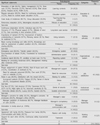Abstract
Purpose
The purpose of this study was to identify experiences of incidents and to explore the perceptions of Patient Safety Culture between two groups using nursing homes in Korea; employees and patients and their families.
Methods
In 2010 in-depth interviews were used to collect data from 56 participants (38 employees, and 18 patients and family members). The data were analyzed using inductive content analysis.
Results
The analysis scheme resulting from employees' data consisted of 7 categories and 22 subcategories, after 216 significant statements were analyzed and categorized. The 7 categories were education and training (24.5%), working attitude (23.6%), organizational system (19.0%), job satisfaction (18.5%), institutional environment (6.5%), manager leadership (4.2%), and work climate (4.7%). The analysis scheme resulting from patient and family data consisted of 6 categories and 7 subcategories after 24 significant statements were analyzed and categorized. Education and training among categories of employees were excluded.
Figures and Tables
References
1. Agency for Healthcare Research and Quality. Nursing home surveys on patient safety culture. 2008. Retrieved December 1, 2012. from http://www.ahrq.gov/qual/patientsafetyculture/nhsurvindex.htm.
2. Ahn SH. Analysis of risk factors for patient safety management. J Korean Acad Nurs Adm. 2006. 12:373–384.
3. Bonner AF, Castle NG, Perera S, Handler SM. Patient safety culture: A review of the nursing home literature and recommendations for practice. Ann Longterm Care. 2008. 16(3):18–22.
4. Castle NG, Sonon KE. A culture of patient safety in nursing homes. Qual Saf Health Care. 2006. 15:405–408. http://dx.doi.org/10.1136/qshc.2006.018424.
5. Chen IC, Li HH. Measuring patient safety culture in Taiwan using the hospital survey on patient safety culture (HSOPSC). BMC Health Serv Res. 2010. 10:152. http://dx.doi.org/10.1186/1472-6963-10-152.
6. Cox S, Cox T. The structure of employee attitudes to safety: A European example. Work Stress. 1991. 5(2):93–106. http://dx.doi.org/10.1080/02678379108257007.
7. Creswell JW, Clark VLP. Designing and conducting mixed methods research. 2007. California: Sage.
8. Feng X, Bobay K, Weiss M. Patient safety culture in nursing: A dimensional concept analysis. J Adv Nurs. 2008. 63:310–319. http://dx.doi.org/10.1111/j.1365-2648.2008.04728.x.
9. Glaser BG, Strauss AL. The discovery of grounded theory: Strategies for qualitative research. 1967. New York: Aldine.
10. Handler SM, Castle NG, Studenski SA, Perera S, Fridsma DB, Nace DA, et al. Patient safety culture assessment in the nursing home. Qual Saf Health Care. 2006. 15:400–404. http://dx.doi.org/10.1136/qshc.2006.018408.
11. Institute of Medicine. Crossing the quality chasm: A new health system for the 21st century. 2001. Washington, DC: National Academy Press.
12. Kang MA, Kim JE, An KE, Kim Y, Kim SW. Physicians' perception of and attitudes towards patient safety culture and medical error reporting. Korean J Health Policy Adm. 2005. 15(4):110–135.
13. Kang YH. Culture. 2012. 11. 01. Retrieved November 1, 2012. from http://terms.naver.com/entry.nhn?cid=476&docId=426412&mobile&categoryId=476.
14. Kim MC, Cho HK, SunWoo S, Kim SW. Prevalence and associated factors of fall among the elderly in nursing home. J Korean Geriatr Soc. 1999. 3(4):29–38.
15. Kim EK, Kang MA, Kim HJ. Experience and perception on patient safety culture of employees in hospitals. J Korean Acad Nurs Adm. 2007. 13:321–334.
16. Kim SS, Lee ES. A study on accidents of the elderly in urban areas. Korean J Nurs Query. 1999. 8(2):202–224.
17. Krumberger JM. Building a culture of safety. RN. 2001. 64(1):32ac2–32ac3.
18. Lee EO, Lim EY, Park HA, Lee IS, Kim JI, Bae JY, et al. Nursing research and statistical analysis. 2009. Seoul: Soomoonsa.
19. Lee YM. Safety accident occurrence to perceptions of patient safety culture of hospital nurses. J Korea Acad Ind Coop Soc. 2012. 13(1):117–124.
20. National Health Insurance Corporation. Number of long-term care facilities. 2012. Retrieved October, 2012. from http://www.longtermcare.or.kr/portal/site/nydev/MENUITEM_ORGSEARCH/.
21. Park SJ, Kang JY, Lee YO. A study on hospital nurses' perception of patient safety culture and safety care activity. J Korean Crit Care Nurse. 2012. 5(1):44–55.
22. Sexton JB, Helmreich RL, Neilands TB, Rowan K, Vella K, Boyden J, et al. The safety attitudes questionnaire: Psychometric properties, benchmarking data, and emerging research. BMC Health Serv Res. 2006. 6:44. http://dx.doi.org/10.1186/1472-6963-6-44.
23. The National Institute of the Korean Language. Standard Korean Language Dictionary. 2012. Retrieved from http://www.korean.go.kr/eng/index.jsp.




 PDF
PDF ePub
ePub Citation
Citation Print
Print







 XML Download
XML Download